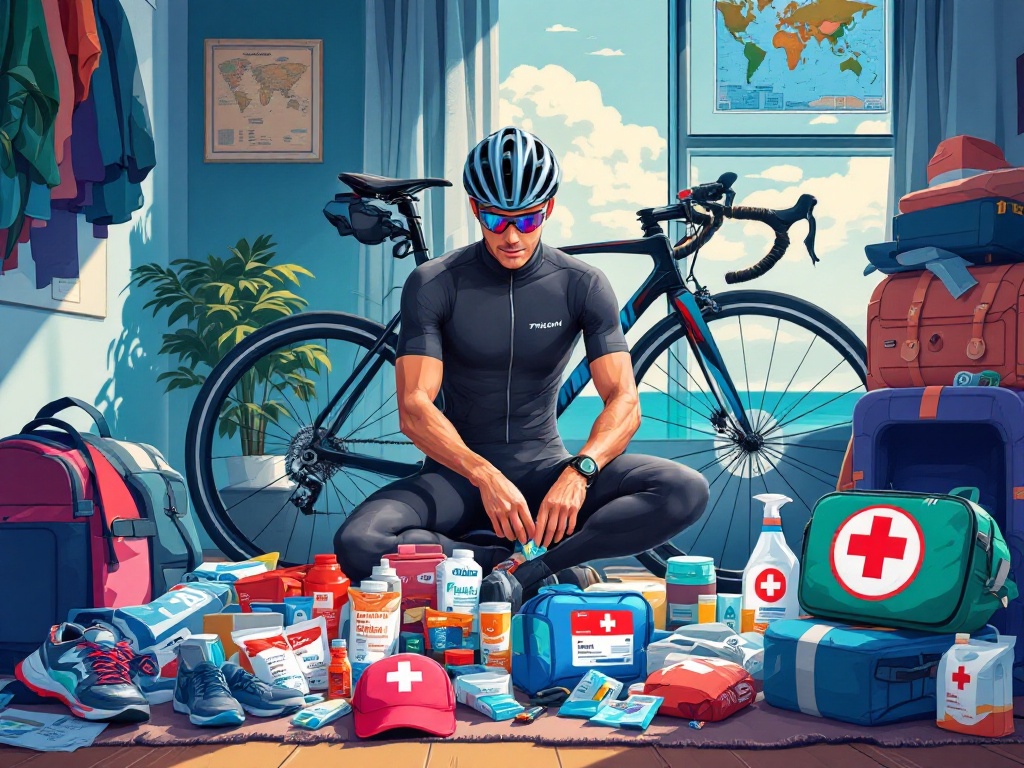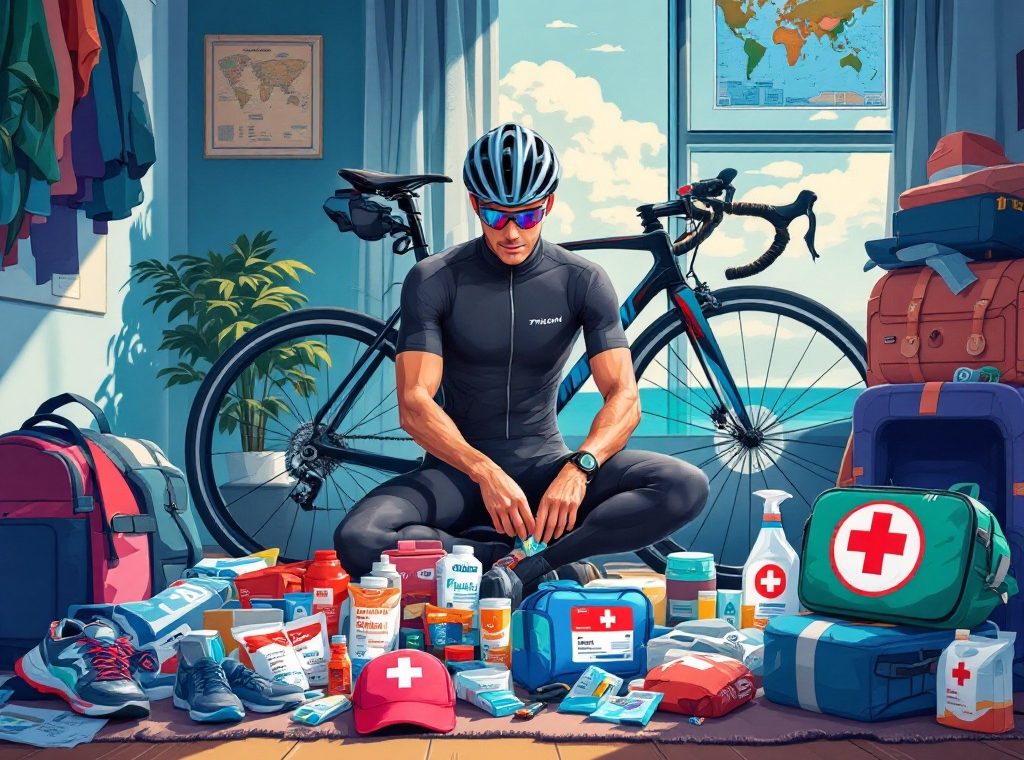Packing Tips for Triathletes Traveling Abroad
Competing in an international triathlon? Learn how to pack like a pro! This guide covers everything from essential gear like your wetsuit, bike, and running shoes, to often-overlooked items like race-day nutrition and a first-aid kit. Discover how to navigate airline regulations for sports equipment, utilize packing cubes for optimal organization, and even maintain your training schedule while abroad. Prepare for a smooth, stress-free race experience. Read on to master the art of triathlon travel packing.
Important information

- Pack all essential triathlon gear: wetsuit, bike (in a suitable case), helmet, cycling shoes, running shoes, and race outfit.
- Check the weather forecast and pack appropriate clothing for training and race day.
- Review airline sports equipment policies, especially regarding bikes, to avoid extra fees.
- Bring essential documents: passport, visa, race registration, and travel confirmations.
- Pack a small first-aid kit, essential medications, and preferred race-day nutrition.
Packing Tips for Triathletes Traveling Abroad
Packing for an International Triathlon: A Comprehensive Guide
Start Early
Begin packing several weeks before your triathlon to avoid last-minute stress and ensure you have all the necessary equipment.
Sport-Specific Gear
Pack all essential gear for each leg of the triathlon. This includes your wetsuit, bike, helmet, cycling shoes, running shoes, and race outfit.
Check the Forecast
Review the weather forecast at your destination and pack appropriate clothing for training and race day.
Essential Accessories
Remember important accessories such as goggles, a race belt, and your preferred nutrition products.
Health Essentials
Pack any personal medications, a first-aid kit, and any necessary supplements.
Luggage
Choose a sturdy, well-organized bag to protect your gear during travel.
Airline Policies
Review your airline’s sports equipment policies to avoid extra baggage fees. If traveling with your bike, consider a travel-friendly bike bag or case.
Race Day Essentials
Don’t forget your race bib, timing chip, and any necessary medications or supplements.
Create a Comprehensive Triathlon Packing List
Pack strategically for a smooth triathlon experience. Essential items include swimwear, a bike, running shoes, and a helmet. Remember nutrition and hydration supplies, along with appropriate clothing for the weather conditions. Don’t forget your race number, goggles, and transition gear. Crucially, bring your passport and race registration confirmation. A pre-race checklist is invaluable for ensuring you have everything.
Packing cubes can help organize your gear by discipline: swim, bike, and run.
Rolling your clothes, rather than folding, saves space and reduces wrinkles. Prioritize light, quick-drying fabrics to minimize bulk.
A first-aid kit, sunscreen, sunglasses, and any necessary medications are also important additions. With these items packed, you’re ready to race!
Research Weather Conditions for Travel Planning
Checking the weather forecast before your trip ensures you pack appropriate clothing and gear. Consider the average temperature, humidity, and chance of rain to make your training and racing experience more comfortable.
Understand Airline Luggage Allowance and Weight Limits
Airline luggage rules vary, so check your airline’s website for size and weight limits before you fly. Weighing your bags first can prevent unexpected fees at the airport and ultimately save you money.
Optimize Weight Distribution Between Bags
Distribute heavy items evenly in your checked luggage to prevent any single bag from becoming overweight. This helps avoid extra baggage fees and unpleasant surprises at the airport. Pack strategically and save.
Use Packing Cubes for Better Organization
Packing cubes offer a great way to organize your triathlon gear. They help separate your swim, bike, and run items, maximizing luggage space with their compression capabilities. This efficient organization makes finding items easy, eliminating the need to rummage through your bag.
Organize Belongings with Space-Saving Bags
Space-saving bags are excellent for compressing clothes and other soft items, creating extra luggage space. They also protect belongings from moisture and wrinkles. Popular choices include vacuum-sealed bags and compression cubes. These are particularly useful for triathletes packing wetsuits and gear who need the extra room. However, check airline regulations regarding vacuum-sealed bags, as pressure changes can sometimes cause issues. Compression cubes offer a practical alternative, neatly compressing items without vacuuming.
Vacuum-Sealed Bags
Excellent for maximizing space, these bags remove air to compress items tightly. Ideal for storing bulky items like sweaters and jackets, they protect against moisture, dust, and insects. Consider airline regulations before using them, as pressure changes during flights might pose challenges.
Compression Cubes
These zippered cubes compress items without vacuuming, making them versatile and convenient for travel. They help organize luggage and reduce wrinkles. A great option for triathletes and other athletes who need to pack wetsuits or other gear efficiently, they offer effortless compression and easy access to packed items.
Pack Essential Items in Your Carry-On
Before your race abroad, follow these essential packing steps:
Gather your travel documents. This includes your passport, visas, race registration confirmation, flight and hotel details, and any other important documents.
Pack essential medications and a small first-aid kit for minor health issues.
Include toiletries and a change of clothes for comfort and hygiene.
Remember your phone and charger, along with any other necessary electronics.
Pack your preferred race-day nutrition, such as gels or chews.
If needed, bring an extra pair of glasses or contacts.
Use Laundry Facilities to Reduce Luggage Load
Traveling light is a breeze for athletes who pack quick-drying clothing and wash their clothes on the go. This smart strategy simplifies travel and offers greater flexibility.
Packing and Transporting Triathlon Gear
Choose the right bike case. Bike boxes offer basic protection for simple transport. Soft cases provide extra padding for sensitive components. Hard cases offer the ultimate protection but may require more disassembly.
Disassemble your bike if necessary. Hard cases may require removing wheels, pedals, and handlebars. This extra step ensures optimal protection during transit.
Protect your bike’s frame and components. Use padding or bubble wrap to prevent scratches and damage during transport.
Check airline regulations. Contact your airline about specific bike regulations, including weight and size limits, to avoid any issues at the airport.
Consider travel insurance. Travel insurance can provide coverage for potential damage or loss, giving you peace of mind.
Pack thoroughly with extra padding. Ensure a smooth trip by adding extra padding around sensitive parts like the derailleurs and brakes.
Label your case clearly. Make it easy to identify your bike case by clearly labeling it with your name and contact information.
Carefully Pack Your Wetsuit
To preserve your wetsuit, roll it instead of folding, which prevents creases and protects the neoprene. Store it in a protective bag inside your suitcase. For added travel security, a dedicated wetsuit travel bag is a worthwhile investment.
Ensure Safe Bike Transportation Overseas
Remove the front wheel of your bike.
Remove the pedals and handlebars.
Choose a bike case. Hard cases offer the best protection, while soft cases can be suitable if well-padded.
Review the airline’s specific regulations for traveling with bikes.
Protect your bike with padding and secure loose parts like pedals and skewers.
Clean your bike thoroughly to avoid any transport issues.
Travel Essentials for Triathletes
Travel insurance is essential. It covers unexpected medical expenses or accidents abroad.
Pack nutritious snacks. This helps maintain your diet, especially if you have specific needs or if your preferred foods are unavailable at your destination.
On long flights, wear compression socks. These can significantly improve circulation and minimize leg swelling.
Consider Travel Insurance for Medical Coverage
Travel insurance is a crucial investment for any trip, providing essential medical coverage for unexpected illnesses or injuries abroad. Such emergencies can lead to significant financial strain due to high medical costs, but travel insurance helps mitigate these expenses. Consider travel insurance for your next trip to protect your health and ensure peace of mind.
Carry Healthy Snacks and Food from Home
Traveling triathletes must prioritize nutrition for optimal performance. Pack familiar fuel sources, such as your preferred energy gels, chews, and electrolyte powders, for sustained energy during training and races. Portable snacks like nuts, dried fruit, or protein bars are also beneficial. Remember to verify destination food import regulations. A portable blender bottle is highly recommended for preparing quick smoothies and protein shakes, ensuring consistent fueling throughout your trip.
Fueling Strategies
- Pack your favorite energy gels, chews, and electrolyte powders for training and races.
- Bring portable snacks like nuts, dried fruit, or protein bars.
Travel Tips
- Check food import regulations at your destination.
- Use a portable blender bottle for quick smoothies and protein shakes.
Wear Compression Socks During Flights
Compression socks are a traveler’s best friend on long flights, promoting healthy blood flow in the legs to prevent swelling and reduce the risk of deep vein thrombosis (DVT). For a more comfortable journey, consider packing a pair for your next trip.
Training and Race Preparation While Traveling
Packing a dedicated travel kit is essential for triathlon training trips. Fill it with versatile items such as resistance bands for strength work, a jump rope for cardio, and a portable foam roller for muscle recovery. Your swim gear, including goggles, a cap, and earplugs, is vital. A foldable exercise mat is another excellent addition for core workouts and packs down easily. Planning your workouts in advance helps maintain your training schedule while traveling.
Pack a Triathlete Training Travel Kit
Pack efficiently for your training trip with the right gear for swimming, biking, and running.
Swimming
- Goggles,
- Swim cap,
- Swimsuit.
Biking
- Cycling shoes,
- Helmet,
- Cycling shorts.
Running
- Running shoes,
- Socks,
- Comfortable running apparel.
Tech Gear
- Heart rate monitor,
- GPS watch,
- Chargers.
A small first-aid kit with pain relievers, blister treatment, and sunscreen is recommended. Fuel your workouts with energy bars or gels, especially before longer sessions. Don’t overpack, just stick to the necessities.
Include Essential Items in Your Swimming Kit
- Swimsuit.
- Goggles.
- Swim cap.
- Earplugs.
- Nose clip.
- Waterproof watch.
- Quick-dry towel.
Fold an Exercise Mat for Easy Packing
Folding exercise mats offer excellent portability. Unlike roll-up mats, they fold compactly, making them ideal for travel and easy to pack in luggage.
Utilize a Skipping Rope for Running Training
For runners on the go, skipping offers a powerful, space-saving workout that builds essential muscles. A jump rope’s portability makes it the ideal travel companion.


















